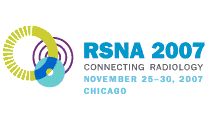
Abstract Archives of the RSNA, 2007
SSA15-04
Assessment of Computer-aided Lung Nodules Detection Algorithm on CT Data Sets Acquired Under Imaging Database Resources Initiative
Scientific Papers
Presented on November 25, 2007
Presented as part of SSA15: Physics (Thoracic CAD )
Anna K. Jerebko PhD, Abstract Co-Author: Employee, Siemens AG, Malvern, PA
Jinbo Bi, Abstract Co-Author: Employee, Siemens AG
Matthias Wolf, Abstract Co-Author: Researcher, Siemens AG, Malvern, PA
Senthil Periaswamy PhD, Abstract Co-Author: Nothing to Disclose
Jianming Liang PhD, Abstract Co-Author: Employee, Siemens AG
Sangmin Park PhD, Presenter: Employee, Siemens AG
To assess the performance of automatic lung nodule detection algorithm (research prototype) on the data acquired by Imaging Database Resources Initiative of the Lung Imaging Database Consortium (LIDC/IDRI) public/private partnership of the U.S. National Cancer Institute.
The data set included 57 thin-slice (1-2mm) IDRI MDCT scans: 16 Philips (Brilliance 40 and 16P, B, C and D convolution kernels(CK)), 41 GE (Lightspeed Ultra, 16 and Power, 'STANDARD' CK) and 31 mixed (25 2mm and six 3mm slice thickness) Siemens cases (Sensation 16 and 64, B30f and B45f CK). The cases were marked per the LIDC process: four radiologists, outlined nodules >3mm and marked locations of the smaller ones. Reads were consolidated after an un-blinded read. Detections were consolidated if the center of the contour provided by one radiologist was located inside the contour marked by another radiologist. Detections <3mm were consolidated based on locations proximity. A confidence rating 1-4 was assigned based on number of radiologists detecting the nodule. 21 of IDRI GE cases were added to a proprietary algorithm development image set that consisted of 223 thin-slice images from sources outside of IDRI.
The algorithm trained on the development set was tested on the remaining 67 IDRI cases. The sensitivity was estimated for nodules from 3 to 30mm. Sensitivity for IDRI Philips cases was 74.2% (23/31 nodules) with 2.9 false positives per case (FP) at confidence level (CL) =1, 80.8% (21/26) with 3.1 FP at CL=2, 83.33% (20/24) with 3.1 FP at CL=3 and 90% (18/20) with 3.3 FP at CL=4. The sensitivity for IDRI GE cases was 87.1% (27/31) with 3.0 FP at CL=1, 88.89% (24/27) with 3.1 FP at CL=2, 86.36% (19/22) with 3.6 FP at CL=3 and 93.33% (14/15) with 3.8 FP at CL=4. The sensitivity for IDRI Siemens cases was relatively lower while the specificity was higher, due to low CK and thicker slices: 71.1% (32/45) with 1.1 FP at CL=1, 73.81% (31/42) with 1.2 at CL=1.2, 76.92% (30/39) with 1.2 FP at CL=3 and 80.65% (25/31) with 1.4 FP at CL=4.
The sensitivity of CAD algorithm was directly correlated with CL (number of radiologists in the cohort that detected a nodule).
CAD for lung nodule detection in MDCT
Jerebko, A,
Bi, J,
Wolf, M,
Periaswamy, S,
Liang, J,
Park, S,
Assessment of Computer-aided Lung Nodules Detection Algorithm on CT Data Sets Acquired Under Imaging Database Resources Initiative. Radiological Society of North America 2007 Scientific Assembly and Annual Meeting, November 25 - November 30, 2007 ,Chicago IL.
http://archive.rsna.org/2007/5011566.html

